避难植物对粉虱种群和红辣椒的影响生产
IF 1.7
Q3 PLANT SCIENCES
引用次数: 0
摘要
2019年3月至6月,在印度尼西亚西亚齐省Meulaboh的Teuku Umar大学农学院实验园进行了研究,重点确定了避难植物对粉虱种群和几个红辣椒品种(Capsicum annuum L.)产量的影响。遗传材料由3个辣椒基因型TM-999和2个杂交品种Lado F1和Lidia F1组成。试验采用3 × 2分割区设计,设3个重复。研究的因素是粉虱的存在。避难所(R)植物作为主要地块,包括R0 =对照,R1 =百日菊,R2 = Kenikir。红辣椒基因型由V1 = TM-999、V2 = Lado F1、V3 = Lidia F1组成。研究变量为粉虱种群测定、侵染率百分比和块地辣椒产量。结果表明,避难植物对粉虱种群数量、害虫侵害率和辣椒亩产均有较大影响。具体而言,避难植物对白蝇种群(黄蝇1.41%,对照11.89%)、害虫侵害率(黄蝇44.44%,对照100%)和亩产(黄蝇23.59 g,对照23.07 g)均有显著影响,对减少白蝇发育/产量有显著影响。本文章由计算机程序翻译,如有差异,请以英文原文为准。
EFFECT OF REFUGIA PLANTS ON WHITEFLY POPULATION AND RED CHILI (CAPSICUM ANNUUM L.) PRODUCTION
Determining the effects of the refugia plant on the whitefly population and the production of several cultivars of red chili (Capsicum annuum L.) was the focus of research conducted from March to June 2019 in the experimental garden, Faculty of Agriculture, Teuku Umar University, Meulaboh, West Aceh Regency, Indonesia. The genetic materials consisted of three chili genotypes, i.e., cultivar TM-999 and two hybrid cultivars, Lado F1 and Lidia F1. The experiment in a 3 × 2 split plot design had three replications. The factor studied was the presence of a whitefly. The Refugia (R) plants, used as main plots, included R0 = Control, R1 = Zinnia, and R2 = Kenikir. Red chili genotypes comprised the sub-plots, i.e., V1 = TM-999, V2 = Lado F1, and V3 = Lidia F1. The studied variables were the whitefly population determination, the percentage of attack rate, and the chili production per plot. The results showed that Refugia plants greatly affected the whitefly population, portion of pest attack rates, and chili production per plot. Specifically, the refugia plant highly affected the whitefly population (Refugia kenikir 1.41% compared with control 11.89%), the percentage rate of pest attack (Refugia kenikir 44.44% compared with 100% of check), and production per plot (kenikir 23.59 g compared with the control’s 23.07 g). Refugia plants are influential in reducing whitefly development/production.
求助全文
通过发布文献求助,成功后即可免费获取论文全文。
去求助
来源期刊

Sabrao Journal of Breeding and Genetics
农林科学-奶制品与动物科学
CiteScore
1.90
自引率
50.00%
发文量
63
期刊介绍:
The SABRAO Journal of Breeding and Genetics is an international journal of plant breeding and genetics research and was first published in 1969. It is the official publication of the Society for the Advancement of Breeding Research in Asia and Oceania (SABRAO).
Its objectives are to: promote the international exchange of research information on plant breeding and genetics, by describing new research findings, or ideas of a basic or practical nature; and be a medium for the exchange of ideas and news regarding members of the Society.
The Journal gives priority to articles that are of direct relevance to plant breeders and with emphasis on the Asian region. Invited for publication are research articles, short communications, methods, reviews, commentaries, and opinion articles. Scientific contributions are refereed and edited to international standards.
The journal publishes articles for SABRAO members mainly. The Journal preferred strongly that at least one author should be a current member of the Society. Non-members may also publish in the journal.
 求助内容:
求助内容: 应助结果提醒方式:
应助结果提醒方式:


